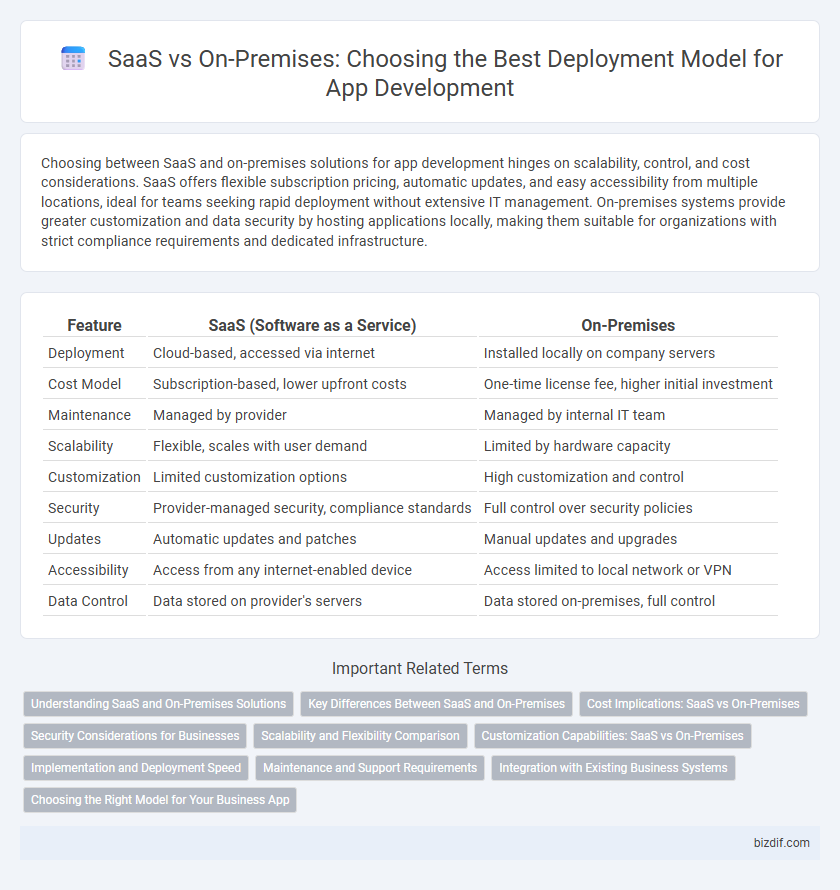Choosing between SaaS and on-premises solutions for app development hinges on scalability, control, and cost considerations. SaaS offers flexible subscription pricing, automatic updates, and easy accessibility from multiple locations, ideal for teams seeking rapid deployment without extensive IT management. On-premises systems provide greater customization and data security by hosting applications locally, making them suitable for organizations with strict compliance requirements and dedicated infrastructure.
Table of Comparison
| Feature | SaaS (Software as a Service) | On-Premises |
|---|---|---|
| Deployment | Cloud-based, accessed via internet | Installed locally on company servers |
| Cost Model | Subscription-based, lower upfront costs | One-time license fee, higher initial investment |
| Maintenance | Managed by provider | Managed by internal IT team |
| Scalability | Flexible, scales with user demand | Limited by hardware capacity |
| Customization | Limited customization options | High customization and control |
| Security | Provider-managed security, compliance standards | Full control over security policies |
| Updates | Automatic updates and patches | Manual updates and upgrades |
| Accessibility | Access from any internet-enabled device | Access limited to local network or VPN |
| Data Control | Data stored on provider's servers | Data stored on-premises, full control |
Understanding SaaS and On-Premises Solutions
SaaS solutions deliver software over the internet, enabling automatic updates and scalable access without the need for local infrastructure, making them ideal for flexible, remote teams. On-Premises software is installed directly on company servers, offering greater control over data security and customization but requiring significant upfront investment in hardware and maintenance. Understanding the trade-offs between SaaS's cloud-based convenience and On-Premises' in-house control is crucial for aligning application development strategies with organizational needs.
Key Differences Between SaaS and On-Premises
SaaS (Software as a Service) offers cloud-based access, enabling real-time updates, scalability, and reduced upfront costs, while On-Premises solutions require local installation, providing more control over security and customization. SaaS platforms rely on subscription models with ongoing maintenance handled by providers, whereas On-Premises requires significant internal IT resources for maintenance and infrastructure management. Data ownership and compliance can differ, with On-Premises offering greater control over sensitive information compared to SaaS, which depends on third-party security measures.
Cost Implications: SaaS vs On-Premises
SaaS solutions typically offer lower upfront costs due to subscription-based pricing models, eliminating the need for extensive hardware investments or IT infrastructure setup. On-premises applications involve substantial initial capital expenditure for servers, licenses, and ongoing maintenance, which can increase total cost of ownership over time. Operational expenses for SaaS scale predictably with user count, while on-premises costs can fluctuate based on required upgrades, staffing, and energy consumption.
Security Considerations for Businesses
SaaS applications offer built-in security updates and compliance certifications managed by providers, reducing the internal IT burden for businesses. On-premises solutions grant complete control over data security and infrastructure, enabling customized security protocols tailored to specific regulatory requirements. Evaluating risk tolerance and regulatory compliance needs is essential to determine the optimal balance between centralized cloud security and localized data protection.
Scalability and Flexibility Comparison
SaaS applications offer superior scalability by enabling businesses to adjust resources dynamically without significant infrastructure changes, supporting rapid growth and fluctuating user demands. On-premises solutions require substantial hardware investments and manual upgrades to scale, often limiting flexibility and increasing operational costs. Cloud-based SaaS platforms provide greater flexibility in deployment, maintenance, and integration, while on-premises setups grant more control but with constrained adaptability.
Customization Capabilities: SaaS vs On-Premises
On-premises app development offers extensive customization capabilities, allowing businesses to modify software to meet highly specific needs and integrate seamlessly with existing systems. SaaS applications typically provide limited customization options, focusing instead on standardized features and frequent updates that benefit from centralized management. While SaaS delivers faster deployment and lower maintenance, on-premises solutions empower organizations with complete control over software tailoring and data security.
Implementation and Deployment Speed
SaaS applications offer rapid implementation and deployment, with cloud-based infrastructure eliminating the need for complex setup and hardware installation. On-premises solutions typically require longer deployment times due to server configuration, software installation, and integration with existing IT systems. Faster SaaS deployment enables organizations to accelerate time-to-market and quickly adapt to changing business needs.
Maintenance and Support Requirements
SaaS applications typically offer streamlined maintenance and support, as updates, security patches, and technical assistance are managed by the service provider, reducing the internal IT burden. On-premises solutions require dedicated in-house teams for ongoing maintenance, troubleshooting, and infrastructure updates, which can increase operational costs and complexity. Enterprises must evaluate the trade-offs between vendor-managed support in SaaS and the control, but heightened resource demands, of maintaining on-premises software.
Integration with Existing Business Systems
SaaS applications offer seamless integration with existing business systems through APIs and cloud-based connectors, enabling real-time data synchronization and scalability without extensive infrastructure changes. On-premises solutions provide deep customization and control over integrations but often require significant internal IT resources and longer deployment times to connect legacy systems. Choosing between SaaS and on-premises depends on the organization's need for flexibility, control, and the complexity of current IT environments.
Choosing the Right Model for Your Business App
Selecting between SaaS and on-premises app development hinges on factors like cost structure, scalability, and control over data. SaaS offers lower upfront costs, automatic updates, and seamless scalability, ideal for businesses seeking flexibility and reduced IT overhead. On-premises solutions provide greater customization and security, making them suitable for enterprises with strict compliance requirements and existing infrastructure.
SaaS vs On-Premises Infographic

 bizdif.com
bizdif.com